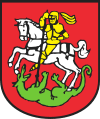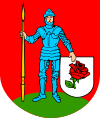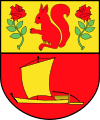Ostróda
| Ostróda | |||
|---|---|---|---|
|
Lakeside | |||
| |||
 Ostróda | |||
| Coordinates: 53°42′N 19°58′E / 53.700°N 19.967°E | |||
| Country |
| ||
| Voivodeship | Warmian-Masurian | ||
| County | Ostróda County | ||
| Gmina | Ostróda (urban gmina) | ||
| Established | 13th century | ||
| Town rights | 1329 | ||
| Government | |||
| • Mayor | Czesław Najmowicz | ||
| Area | |||
| • Total | 14.15 km2 (5.46 sq mi) | ||
| Highest elevation | 120 m (390 ft) | ||
| Lowest elevation | 110 m (360 ft) | ||
| Population (2009) | |||
| • Total | 33,191 | ||
| • Density | 2,300/km2 (6,100/sq mi) | ||
| Time zone | CET (UTC+1) | ||
| • Summer (DST) | CEST (UTC+2) | ||
| Postal code | 14-100 | ||
| Area code(s) | +48 89 | ||
| Car plates | NOS | ||
| Website | http://www.ostroda.pl | ||
Ostróda [ɔsˈtruda] (German: ![]() Osterode in Ostpreußen ) is a town in Ostróda County in the Warmian-Masurian Voivodeship in Poland, with 33,191 inhabitants as of December 31, 2009.
Osterode in Ostpreußen ) is a town in Ostróda County in the Warmian-Masurian Voivodeship in Poland, with 33,191 inhabitants as of December 31, 2009.
Geography
The town lies in the west of the historic Masuria region on the Drwęca river, a right tributary of the Vistula. Lake Drwęca west of the town is part of the Masurian Lake District. Ostróda has become a growing tourist site owing to its relaxing natural surroundings.
The National road 7 from Gdańsk to Warsaw, part of European route E77, passes through Ostróda. The Elbląg Canal connects Ostróda with the Baltic coast.
History

At the site of an original Old Prussian settlement on an island at the river delta where the Drwęca river flows into Lake Drwęca the town of Ostróda evolved. In 1270 the Teutonic Order began constructing wooden earthworks to control the original settlement as well as defend the initial Mazurian and German settlers. The knights named the new town Osterode after Osterode am Harz in Lower Saxony, Germany (now a sister city with Ostróda). Between 1349-1370 the Order replaced the wood-and-earth fort with a stone castle. The town, whose charter traditionally dates to 1335, quickly became a regional administrative center for the Order.
After the Battle of Grunwald in 1410, Klaus von Döhringen conquered Osterode's castle and delivered the town to the victorious Władysław II of Poland. The Polish king brought the body of Ulrich von Jungingen there before travelling to besiege Marienburg (Malbork); the regrouping Teutonic Knights recaptured Ostróda a few months later.
During the Thirteen Years' War (1454–1466), Osterode was repeatedly captured by both the Poles and Prussian Confederation on one side and the Teutonic Knights on the other. From 1525 until 1701 Osterode was part of Ducal Prussia, a fief of Poland, and after 1701 part of Kingdom of Prussia. The majority of inhabitants were Protestant and the Evangelical church books date back to 17th century. In 1818 it became the seat of a Kreis (district) within the Kingdom of Prussia. In 1871 Osterode was included in the newly formed German Reich.
During World War I and the 1914 Battle of Tannenberg, General Paul von Hindenburg had his 8th Army headquarters at the Osterode schoolhouse. As a result of the Treaty of Versailles, on 11 July 1920 the East Prussian plebiscite was organized under the control of the League of Nations, which resulted 97,81% of votes in the Allenstein district to remain in Germany and 2,19% for Poland.
Osterode lost its pre-war Jewish population in the Holocaust. Most of the Osterode citizens had fled during the evacuation of East Prussia, when on 21 January 1945 Osterode was captured by the Soviet Red Army without fighting. However, about 70% of the town was destroyed by arson attacks afterwards. With the conquest by the Soviet Union and the Potsdam Agreement, the town became part of Poland and the remaining German population was expelled.
While it was previously in Olsztyn Voivodeship from 1975 to 1998, Ostróda has been situated in the Warmian-Masurian Voivodeship since 1999.
International relations
Twin towns — Sister cities
Ostróda is twinned with:
Notable residents
- Christian Jakob Kraus (1753–1807), Philosopher, Economist, Linguist
- Gustaw Gizewiusz (1810–1848), Political figure, Folklorist, Translator
- Paul Dahlke (1865-1928), Physician and Buddhist
- Benedykta Mackieło (1893-2007), oldest Pole
- Bruno Karczewski (1913–1971), Wehrmacht officer
- Hans Hellmut Kirst (1914–1989), Author
- Alexander Allerson (born 1930), German actor
- Werner Olk (1938-), footballer and coach
- Maciej Krzykowski, professional Quake player
External links
| Wikimedia Commons has media related to Ostróda. |
| Wikisource has the text of a 1911 Encyclopædia Britannica article about Ostróda. |
- Kirchenbuch Evangelical church book documents (Taufen, Heiraten, Tote) of inhabitants of Osterode since the 1600s.
- Municipal webpage
- Ostróda Online (Polish)
- City history (German)
Coordinates: 53°42′N 19°59′E / 53.700°N 19.983°E



